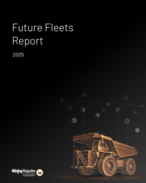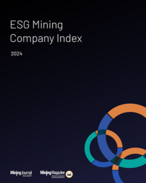It is a title many Australians will not know they have lost. In the past 12 months, while ship after ship have queued up outside Australia’s east coast ports awaiting whatever coal can be spared, Indonesia has quietly overtaken its southern neighbour as the world’s largest exporter of thermal coal.
Over the past five years as Asia’s rampant need for power has taken hold, Indonesia’s export coal production has soared from about 55 million tonnes per annum to around 150Mtpa.
Nearly all of this coal has come from the Indonesian island of Kalimantan, which has hosted a series of major coal discoveries and large mine expansions.
Most notable in recent times has been the Pakar discovery – one of the largest coal discoveries to date on Kalimantan.
Part-owned by the son of former Indonesian President Bacharuddin Jusuf Habibie, more than $US10 million ($A11.9 million) has been spent on drilling at Pakar to delineate a JORC-compliant resource containing a whopping 3.3 billion tonnes of thermal coal.
Pakar, which is understood to remain open in most directions, has consequently helped make not just the east coast, but also the central eastern regions of Kalimantan, one of the most popular destinations for coal explorers in the world. The prospect of finding another Pakar, plus the ravenous way in which China and India is snapping up new coal production, is what makes Churchill joint managing director James Hamilton so excited about his company’s prospects.
“This is, in my opinion, the hottest coal province in the world,” Hamilton said.
Kalimantan is already home to approximately 20 large-scale mines, the biggest of which is Kaltim Prima, which produces approximately 35Mtpa of coal off the back of a 4.5Bt resource base.
It is this track record of production growth that has prompted explorers (both big and small) to peg much of the ground in the area. And few have secured land packages bigger than Churchill.
Churchill’s first project in Kalimantan, Sendawar, covers more than 1000 square kilometres – “bigger than Singapore”, says Hamilton – while East Kutai sits on 400sq.km of ground just to the northeast of Pakar.
While Churchill has its foot on a substantial chunk of Kalimantan, the land position was by no means the result of a mad land grab.
Along with his co-managing director Paul Mazak, Hamilton – himself a former financial journalist and in fact the founder of RESOURCESTOCKS – evaluated “more than 30” different projects before settling on Sendawar and East Kutai.
“The company is very fortunate to have Paul on board,” Hamilton said. “Having spent many years working intimately with Indonesian government organisations, high net worths and senior political figures, Paul has been able to use his network to fast-track Churchill’s ground build-out.”
While Sendawar represented Churchill’s first move into coal exploration, it is East Kutai that is garnering much of the company’s current attention, which has resulted in the signing of a Heads of Agreement (HOA) with Indonesian power utility PT Ridlatama Bangun Mandiri.
Under the HOA Churchill will supply approximately 840,000 tonnes of coal per annum for 30 years to feed two 30 megawatt powers stations PT RBM is building in Kalimantan.
Churchill picked up an option to purchase East Kutai in February from local company PT Techno Coal Utama Prima.
In the short time since then, Churchill has already discovered thermal coal in multiple seams, with 15 out of 19 holes drilled in the project returning coal seams of varying widths. Among the better seam thicknesses identified to date are 19.25m, 14.2m, 13.8m and 9.35m.
Churchill has only examined a small portion of the East Kutai leases, with the company’s local geologists to date only scouting for coal outcrops in one of the two large tenements that make up the project.
While observers keenly await more drilling results at East Kutai for tonnage, Hamilton stresses that the drilling to date has been to verify targets rather than define a resource.
Churchill is drilling using man portable drill rigs that can be moved through the thick vegetation by hand and supported by four-wheel drives. The company has planned an aggressive 10,000m exploration program to test southern targets before Christmas.
Analysis of the coal recovered from East Kutai has found that while its calorific value (average 5261kcal/kg) or energy levels are – as is typical of thermal coal – lower than those of conventional coking coal, the coal is very low in ash (average 5.72%) and sulphur (0.14%).
Preliminary discussions with coal marketing firms suggest the coal has a market as a blending product with high sulphur Chinese coals, a direct feedstock for Indian power utilities or a mine-mouth domestic power station product.
Already, the success to date has the Churchill team setting a coal resource target of 100Mt.
The company has also already begun weighing up the feasibility of transporting any mineable coal resources defined at East Kutai to the nearby natural deepwater port of Sengatta via either a slurry pipeline or by road.
While coal slurry pipelines are not common in Indonesia, they have been used successfully in many other parts of the world. The key requirement for slurrying is water, which there is no shortage of in Kalimantan.
While such a method would add to the initial capital costs of a development, Churchill would stand to benefit from lower long-term operating costs.
“Slurrying is very cost-effective in the long term but really it is the ultimate size of the resource which will determine which way we go and what the optimum output tonnage will be,” Hamilton said.
Meanwhile, Churchill will be taking another look at its Sendawar project following the recent completion of induced polarisation surveys over the project.
Churchill’s early efforts at Sendawar, in which Churchill owns an 80% stake, centred on drilling along the border the project shares with the privately owned Gunang Bayan mine, which has a 300Mt resource.
That program met with mixed results and Churchill is now concentrating on refining the dozen or so targets identified through the IP for a fresh drill campaign. The company is also looking at the coal seam methane potential of the project.
Hamilton plays down the sovereign risk issue of working in Indonesia, pointing to the success of coal miner Straits Resources and AIM-listed company Archipelago Resources as examples of Western companies growing shareholder value by operating in Indonesia. In addition, mid-tier mining darling Oxiana recently added to its exposure to Indonesia through its acquisition of the Martabe gold project. Oxiana is already exploring in Kalimantan.
Hamilton saysArticle continues, click here.























